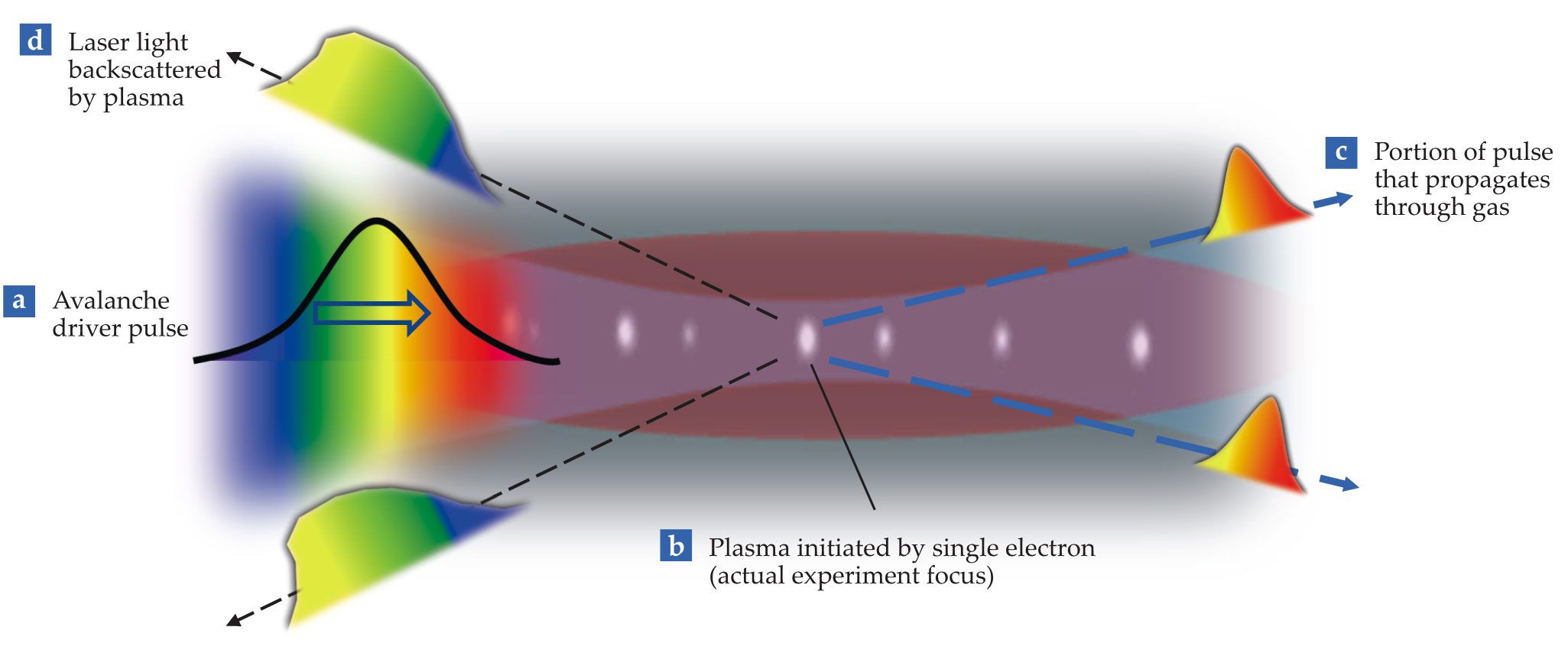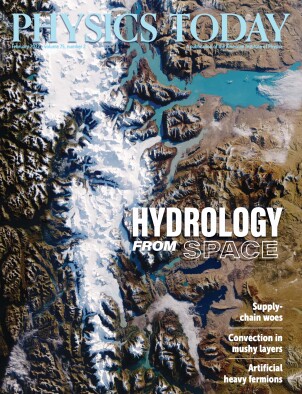Extreme sensitivity charge detection
DOI: 10.1063/PT.3.4948
After Theodore Maiman’s demonstration of the laser in 1960, researchers quickly discovered that tightly focused laser pulses generated a bright spark of ionized air. The initial reports caught the physics community off guard; in the words of an early researcher, C. Grey Morgan, a “flash of laser light can set the air on fire!” Because each laser photon didn’t have enough energy to knock an electron off an air molecule, it should have been impossible for the laser to ionize the air directly. Eventually, researchers realized that the extremely high electric fields at the laser’s focus were driving an electron avalanche breakdown, an already well-known process using high static fields and high-power microwaves.
An initial population of free electrons gains energy by acceleration in the laser field, ionizing other molecules in a cascading, exponential process. The source of the initial population of electrons was a mystery, however, and it spurred pioneering theoretical work by Leonid Keldysh. In the quantum or multiphoton ionization (MPI) limit—at moderate intensity and short laser wavelength—of the theory, an electron is liberated when an atom absorbs many photons simultaneously. In the semiclassical limit (at high intensity and long wavelength), the laser’s large electric field pulls electrons out of atoms by tunneling ionization.
With the basic process understood, researchers rushed to apply laser-driven avalanche breakdowns to such varied fields as breakdown spectroscopy, fast switching of high voltages, laser surgery, and laser machining. In this Quick Study, we recount the physics governing the laser-driven sparks and show how revisiting early experiments with new technology has uncovered the ability to pinpoint individual electrons in ambient gases.
Electron cascades
In a discharge induced by a static field or microwaves, breakdown begins with a single free electron—usually originating from cosmic rays or dust—that accelerates along the electric field until it collides with and ionizes a molecule. For air at standard temperature and pressure, the threshold field is about 3 MV/m.
In the electric field of a focused laser pulse—whose frequency is 104 times that of microwaves—electrons don’t accelerate to a sufficient energy for ionization to happen before the field switches sign and accelerates them in the opposite direction. As the sinusoidally quivering electrons elastically scatter off air molecules, their driven motion loses coherence with the laser and they heat up.
Over many such collisions, an electron can gain enough kinetic energy to ionize a neutral molecule. An ionization cascade will develop if the laser-induced heating and ionization overcomes energy and particle losses from the heated volume. The greatly reduced acceleration time in each laser cycle demands a much higher peak electric field, on the order of 10 GV/m for a 1 µm (near-IR) wavelength laser. Such fields may seem extreme, but researchers have routinely generated them since the 1970s by focusing the output from commercial Q-switched lasers, which pack a modest amount of energy into a 10 ns pulse.
Unlike static or microwave breakdowns, which are centimeter-sized or larger, laser-breakdown plasmas can start off in the micron range. Laser-driven electrons in air oscillate in small orbits and randomly change direction as they collide with gas molecules. The rapidly growing free-electron population diffuses into a small blob around the location of the initial free electron that seeds the process. As long as the laser pulse is on, the local electron density continues to increase, accompanied by outward diffusion, until there are enough electrons in the heated volume to respond collectively in resonance with the laser and absorb energy even more rapidly. Eventually, the breakdown explodes outward as a bright plasma spark.
An IR breakthrough
The remarkable growth of a laser-driven breakdown suggests that avalanches might have been used to detect single free electrons. Early researchers, however, had no way to tell if the avalanche began with 1, 100, or even 1 million electrons. In the end, the breakdown would saturate to the same bright plasma spark, in which every molecule was ionized. More fundamentally, MPI of oxygen molecules in air could liberate many electrons early in the pulse and mask the effect of any seed electrons present. And with nanosecond laser pulses, air-breakdown plasmas can grow to the total volume of the laser focus, with an attendant loss of spatial resolution for locating seed electrons.
We found the solution to those problems while pursuing another topic—the remote detection of radioactive sources. All radioactive materials emit high-energy particles that can be directly detected by Geiger counters, scintillators, or spectrometers. As the high-energy particles travel outward from the source, they knock electrons off air molecules and leave behind a trail of ionized air.
Because of the combined effects of the inverse square drop-off with distance and attenuation by the air, however, the flux of high-energy particles becomes extremely weak. Constant bombardment leads to a small population of free electrons and negative ions (on the order of a few thousand per cubic centimeter) in the air near the source. Although that level of ionization is far too low to generate enough optical emission to see from a distance, focusing a laser in that air could—you guessed it—drive a bright breakdown spark.

A laser emits a short chirped pulse through air. (a) The red part of its spectrum precedes the blue. (b) Light at the laser’s focus produces a plasma blob initiated by a single electron. The series of blobs pictured are experimental data. (c) Beyond the focus, a portion of the driver pulse—the early (red) part of the spectrum—continues propagating. (d) Another portion of the pulse is backscattered by the plasma. That spectrum is the main diagnostic and is collected by a spectrometer.

Our early experiments using near-IR lasers repeatedly failed to detect air ionization induced by an alpha particle source. Because of MPI, the exact same breakdowns occurred with or without the source present. Fortuitously, our lab had recently obtained an ultrashort-pulse, mid-IR laser (3.9 µm) intended for high-field nonlinear optics experiments, and we decided to try that laser as an avalanche driver by stretching its pulse to 50 ps. (That duration is long enough to grow the avalanche over multiple exponentiation times, but not so long that avalanche growth can easily be seeded by the “noise” of dust, cosmic rays, or background radiation.) And most importantly, MPI was expected to be strongly suppressed by the much lower photon energy.
The effect was immediate and distinctive: Without the radioactive source present, no avalanches happened, and with a low radioactive source flux, there appeared small, spatially discrete, and countable laser-driven breakdowns in the laser focus, seeded by individual electrons. By scanning the position of the radioactive source, we were able to reduce the initial electron density to the point where only one breakdown was seeded—by a single electron in the laser focus.
Although we diagnosed those laser-driven avalanches simply by collecting the total light emission from the plasma, the most sensitive and quantitative diagnostic for remote detection was the backward-scattered IR radiation from breakdown plasmas, as shown in the
The time delay provides a quantitative measure of remote charge density and hence radioactive source strength: More free charges in the laser focus lead to a shorter avalanche delay and a redder wing in the backscattered spectrum. Such a single-shot measurement could never have been done prior to the 1990s—it had to await the development of IR-sensitive CCD cameras and superfast electronics.
A clear implication of this discussion is that a laser-driven avalanche is an ultrasensitive diagnostic of any source of free charge in a gas, including the charge induced by another laser pulse. To test theories of ultrashort-pulse laser ionization in dense gases, we recently used a laser-driven avalanche to measure the absolute ionization yield in air generated by an auxiliary ultrashort laser pulse over 14 orders of magnitude. That dynamic range is obtainable in no other way, and it corresponds to one ionization event for every 1016 gas molecules.
The extreme electron amplification in gases driven by IR-wavelength lasers can be viewed as the in situ, spatially resolved analogue of the photomultiplier tube and represents a long-neglected application of avalanches. By the early 1980s, ideal lasers for the application had developed—long wave carbon dioxide lasers with 100 ps pulse durations. But by that point, researchers considered avalanches a solved (albeit complicated and messy) problem, and they had moved on to study strong-field optical ionization in very dilute gases.
The development of modern, time-resolving diagnostics has rekindled our interest in the physics and applications of the laser-driven avalanche, an amazing effect observed from the earliest days of the laser.
References
► C. Grey Morgan, “Laser-induced breakdown phenomena,” Sci. Prog. 65, 31 (1978).
► L. V. Keldysh, “Ionization in the field of a strong electromagnetic wave,” Sov. Phys. JETP 20, 1307 (1965).
► R. M. Schwartz et al., “Remote detection of radioactive material using mid-IR laser-driven electron avalanche,” Sci. Adv. 5, eaav6804 (2019); https://doi.org/10.1126/sciadv.aav6804
D. Woodbury, R. M. Schwartz, H. M. Milchberg, “Measurement of ultralow radiation-induced charge densities using picosecond mid-IR laser-induced breakdown,” Optica 6, 811 (2019). https://doi.org/10.1364/OPTICA.6.000811► D. Woodbury et al., “Absolute measurement of laser ionization yield in atmospheric pressure range gases over 14 decades,” Phys. Rev. Lett. 124, 013201 (2020). https://doi.org/10.1103/PhysRevLett.124.013201
More about the Authors
Daniel Woodbury is a senior electro-optical engineer at Lockheed Martin, in Denver, Colorado. Robert Schwartz is a graduate student in physics, and Howard Milchberg a professor of physics and electrical engineering, both at the University of Maryland in College Park.



